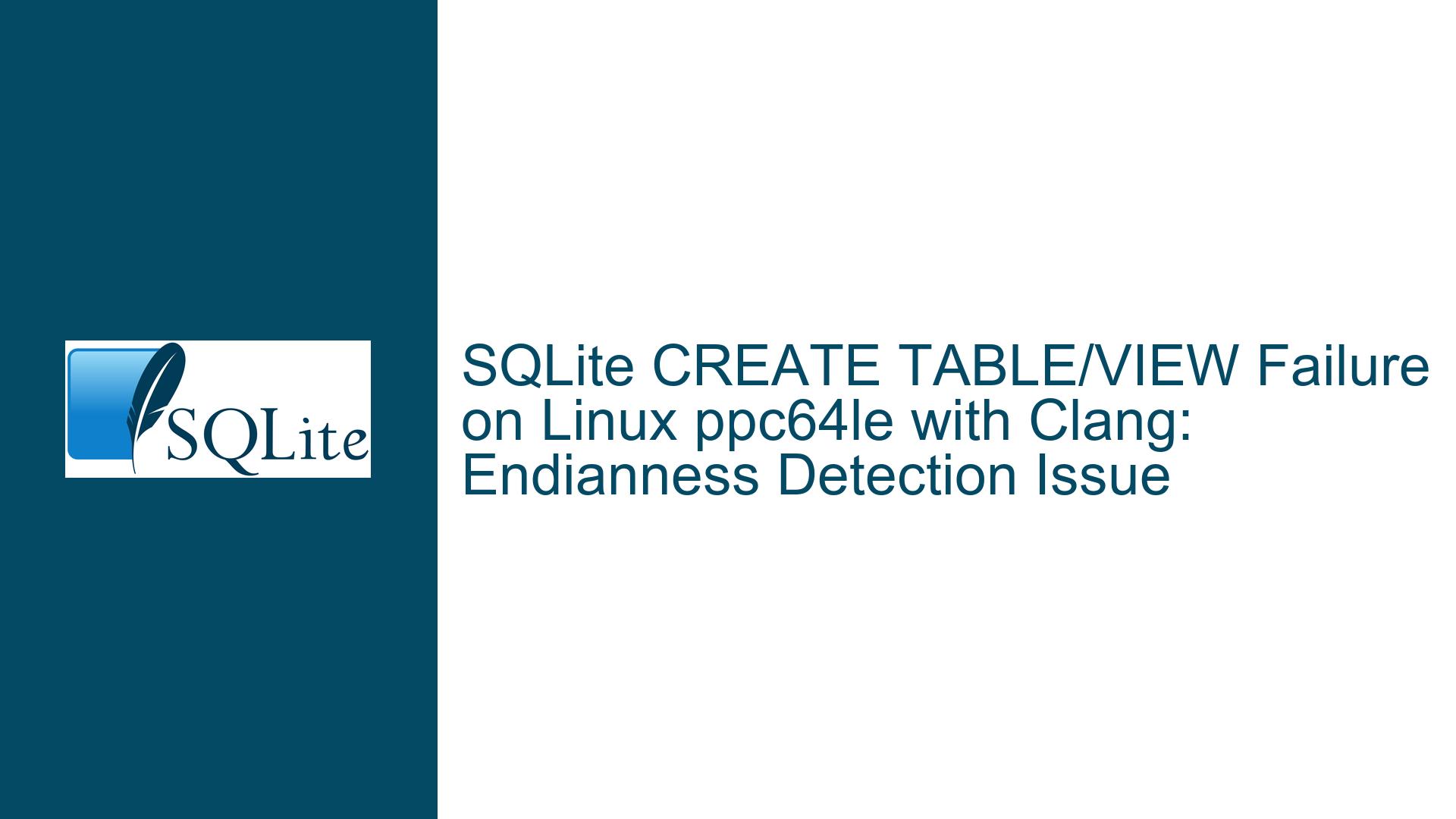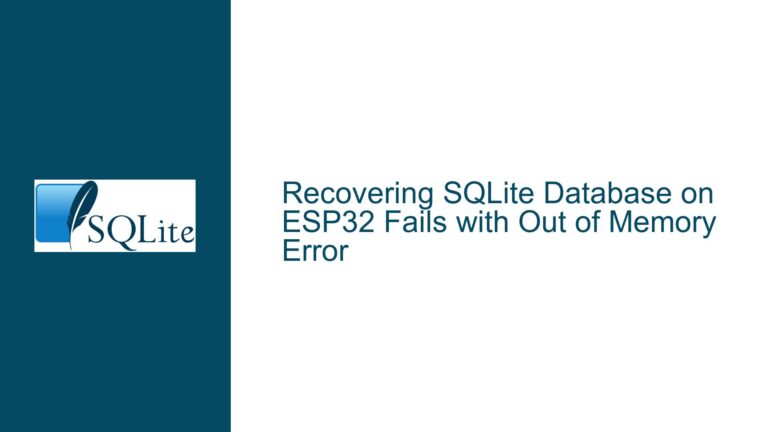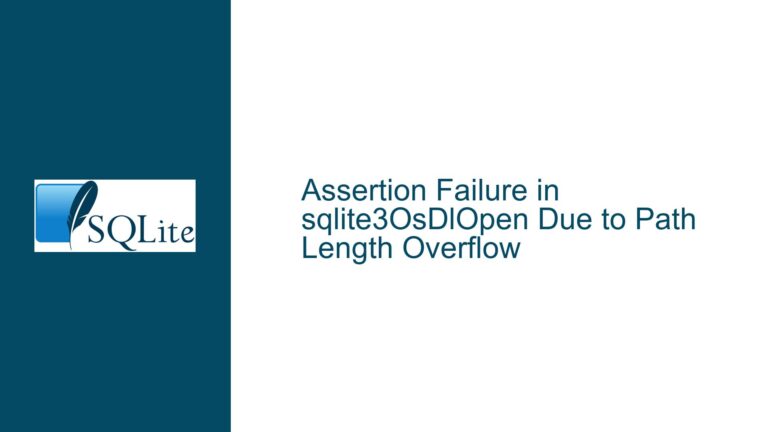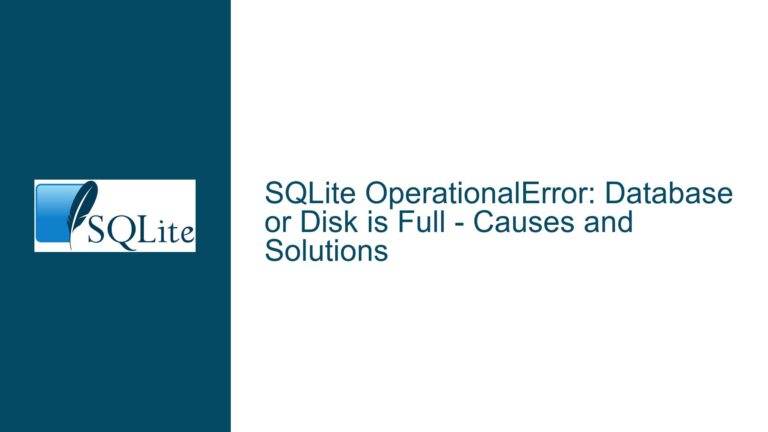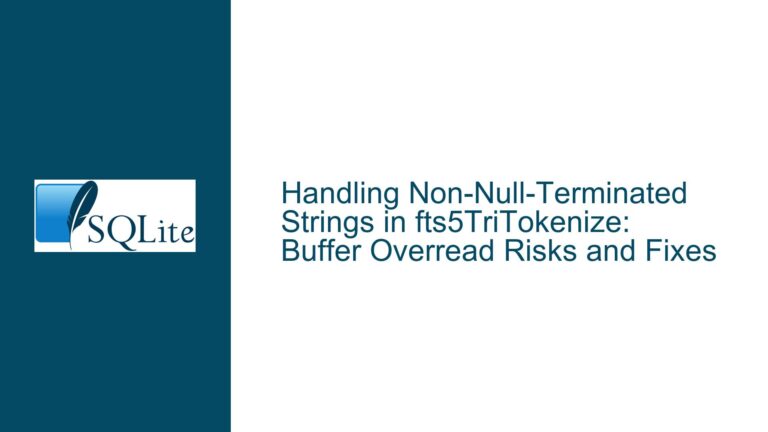SQLite CREATE TABLE/VIEW Failure on Linux ppc64le with Clang: Endianness Detection Issue
Issue Overview: SQLite Fails to Create Tables/Views on Linux ppc64le When Compiled with Clang
When attempting to use SQLite on an IBM POWER8 Linux server (ppc64le architecture), users encounter a critical issue where every CREATE TABLE or CREATE VIEW statement fails, reporting database corruption. This issue manifests specifically when SQLite is compiled with Clang (versions 8 and 14 tested) but does not occur when compiled with GCC (version 8.5.0 tested). The error message returned is "database disk image is malformed (11)," which is misleading because the issue arises even when no database file is involved. This suggests that the problem is not related to disk I/O or file corruption but rather to an internal SQLite or compiler-related issue.
The issue is reproducible on multiple Linux distributions, including CentOS Stream 8 and Ubuntu 16.04, and across different SQLite versions (3.34.1 and 3.40.0). Debugging efforts, including the use of SQLITE_DEBUG, SQLITE_MEMDEBUG, and Valgrind, do not reveal any memory corruption or other obvious issues. Disabling compiler optimizations also does not resolve the problem. However, the issue is resolved when SQLite is compiled with GCC instead of Clang, pointing to a compiler-specific problem.
The root cause of the issue lies in SQLite’s endianness detection mechanism. On ppc64le (little-endian PowerPC), SQLite incorrectly assumes a big-endian architecture when compiled with Clang. This misconfiguration leads to improper handling of data structures and memory alignment, causing the CREATE TABLE and CREATE VIEW statements to fail. The issue is specific to the Clang compiler’s interaction with SQLite’s endianness detection logic on ppc64le systems.
Possible Causes: Endianness Detection Failure in SQLite When Compiled with Clang
The failure of CREATE TABLE and CREATE VIEW statements on ppc64le systems when SQLite is compiled with Clang can be attributed to a misconfiguration in SQLite’s endianness detection logic. Endianness refers to the order in which bytes are arranged within larger data types (such as integers) in memory. Big-endian systems store the most significant byte at the lowest memory address, while little-endian systems store the least significant byte at the lowest memory address. The ppc64le architecture is little-endian, but SQLite incorrectly assumes a big-endian architecture when compiled with Clang.
SQLite relies on compile-time detection of endianness to optimize certain operations, such as byte swapping and data serialization. This detection is typically performed using preprocessor macros and compiler-specific features. On platforms like ppc64le, where the endianness is fixed (little-endian), SQLite should explicitly set the appropriate endianness configuration. However, when compiled with Clang, SQLite’s endianness detection logic fails to correctly identify the platform’s endianness, leading to incorrect assumptions and improper handling of data structures.
The issue is compounded by the fact that SQLite’s error reporting mechanism does not provide meaningful insights into the root cause. The "database disk image is malformed" error is a generic message that typically indicates file corruption or I/O issues. In this case, however, the error is misleading because the problem is unrelated to disk I/O and instead stems from an internal misconfiguration.
The problem is specific to Clang and does not occur with GCC, suggesting that the issue lies in the interaction between SQLite’s endianness detection logic and Clang’s implementation of certain compiler features. This could include differences in how Clang handles preprocessor macros, compiler intrinsics, or platform-specific definitions. The fact that disabling compiler optimizations does not resolve the issue further supports the hypothesis that the problem is related to compile-time configuration rather than runtime behavior.
Troubleshooting Steps, Solutions & Fixes: Resolving Endianness Detection Issues in SQLite on ppc64le with Clang
To resolve the issue of SQLite failing to create tables and views on ppc64le systems when compiled with Clang, the following steps can be taken:
Step 1: Verify Endianness Detection Logic in SQLite
The first step is to examine SQLite’s endianness detection logic to ensure it correctly identifies the platform’s endianness. This logic is typically implemented in the sqliteInt.h header file, where preprocessor macros are used to determine the endianness at compile time. For ppc64le systems, the endianness should be explicitly set to little-endian. If the detection logic is missing or incorrect, it should be updated to explicitly define the endianness for ppc64le.
Step 2: Modify SQLite’s Build Configuration
If the endianness detection logic is correct but the issue persists, the next step is to modify SQLite’s build configuration to explicitly specify the endianness. This can be done by adding a custom compiler flag or modifying the configure script to include the appropriate endianness definition. For example, the -D flag can be used to define a macro that explicitly sets the endianness:
CFLAGS="-DSQLITE_BYTEORDER=1234" ./configure --enable-debug
Here, 1234 represents little-endian byte order. This ensures that SQLite is compiled with the correct endianness configuration, regardless of the compiler’s default behavior.
Step 3: Patch SQLite’s Source Code
If the issue is not resolved by modifying the build configuration, the next step is to patch SQLite’s source code to explicitly handle ppc64le endianness. This involves adding platform-specific code to the sqliteInt.h header file or other relevant parts of the codebase. For example:
#if defined(__ppc64__) && defined(__LITTLE_ENDIAN__)
#define SQLITE_BYTEORDER 1234
#endif
This patch ensures that SQLite correctly identifies ppc64le as a little-endian platform.
Step 4: Test the Patched Build
After applying the patch, rebuild SQLite using Clang and test the CREATE TABLE and CREATE VIEW statements to verify that the issue is resolved. If the problem persists, additional debugging may be required to identify other potential issues in the endianness detection logic or related code paths.
Step 5: Submit a Patch to the SQLite Development Team
If the issue is resolved by modifying SQLite’s source code, consider submitting a patch to the SQLite development team. This ensures that the fix is incorporated into future releases of SQLite, benefiting other users who may encounter the same issue. The patch should include a detailed explanation of the problem, the proposed solution, and any relevant test cases.
Step 6: Use GCC as an Alternative Compiler
If the issue cannot be resolved or if a quick workaround is needed, consider using GCC instead of Clang to compile SQLite. As demonstrated in the original discussion, the issue does not occur when SQLite is compiled with GCC. This workaround is particularly useful in environments where the primary goal is to get SQLite up and running quickly, without investing significant time in debugging and patching.
Step 7: Monitor for Future Updates
Finally, monitor SQLite’s release notes and mailing lists for updates related to endianness detection and ppc64le support. The SQLite development team may address the issue in future releases, eliminating the need for manual patches or workarounds.
By following these steps, users can resolve the issue of SQLite failing to create tables and views on ppc64le systems when compiled with Clang. The key is to ensure that SQLite’s endianness detection logic correctly identifies the platform’s endianness and that the build configuration is adjusted accordingly. With the correct configuration, SQLite should function as expected on ppc64le systems, regardless of the compiler used.
